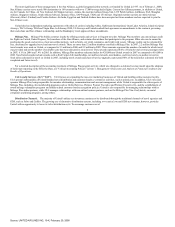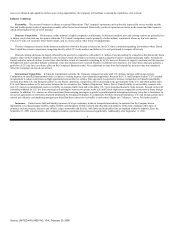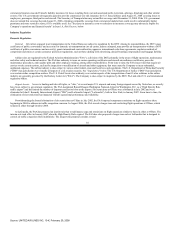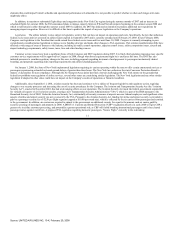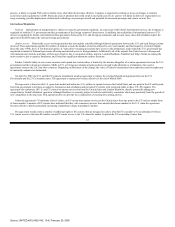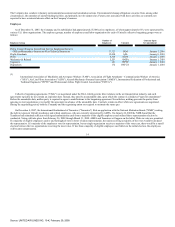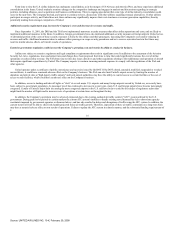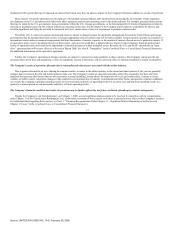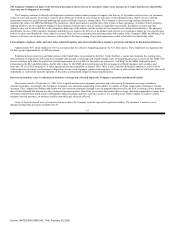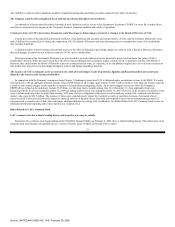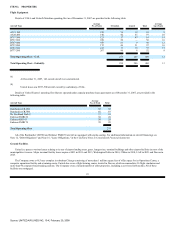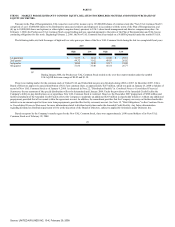United Airlines 2007 Annual Report Download - page 19
Download and view the complete annual report
Please find page 19 of the 2007 United Airlines annual report below. You can navigate through the pages in the report by either clicking on the pages listed below, or by using the keyword search tool below to find specific information within the annual report.
The Company's initiatives to improve the delivery of its products and services to its customers, reduce costs, increase its revenues and increase shareholder
value may not be adequate or successful.
The Company continues to identify and implement continuous improvement programs to improve the delivery of its products and services to its customers,
reduce its costs and increase its revenues. Some of these efforts are focused on cost savings in such areas as telecommunications, airport services, catering,
maintenance materials, aircraft ground handling and regional affiliates expenses, among others. The Company is also reviewing strategic alternatives to
maximize the value of its MRO and Mileage Plus businesses, which may include a possible sale of all, or part of, these operations. A number of the Company's
ongoing initiatives involve significant changes to the Company's business that it may be unable to implement successfully. In addition, revenue and other
initiatives may not be successful due to the competitive landscape of the industry and the reaction of our competitors to certain of our initiatives. The adequacy
and ultimate success of the Company's programs and initiatives to improve the delivery of its products and services to its customers, reduce its costs and increase
both its revenues and shareholder value cannot be assured. There can be no assurance that any transactions with respect to the Company's MRO and Mileage Plus
business will occur, nor are there any assurances with respect to the form or timing of any such transactions or their actual effect on shareholder value.
Union disputes, employee strikes and other labor-related disruptions may adversely affect the Company's operations and impair its financial performance.
Approximately 81% of the employees of UAL are represented for collective bargaining purposes by U.S. labor unions. These employees are organized into
six labor groups represented by six different unions.
Relations between air carriers and labor unions in the United States are governed by the RLA. Under the RLA, a carrier must maintain the existing terms
and conditions of employment following the amendable date through a multi-stage and usually lengthy series of bargaining processes overseen by the NMB. This
process continues until either the parties have reached agreement on a new CBA or the parties are released to "self-help" by the NMB. Although in most
circumstances the RLA prohibits strikes, shortly after release by the NMB carriers and unions are free to engage in self-help measures such as strikes and
lock-outs. All six of the Company's U.S. labor agreements become amendable in January 2010. There is also a risk that dissatisfied employees, either with or
without union involvement, could engage in illegal slow-downs, work stoppages, partial work stoppages, sick-outs or other actions short of a full strike that could
individually or collectively harm the operation of the airline and materially impair its financial performance.
Increases in insurance costs or reductions in insurance coverage may adversely impact the Company's operations and financial results.
The terrorist attacks of September 11, 2001 led to a significant increase in insurance premiums and a decrease in the insurance coverage available to
commercial airlines. Accordingly, the Company's insurance costs increased significantly and its ability to continue to obtain certain types of insurance remains
uncertain. The Company has obtained third-party war risk (terrorism) insurance through a special program administered by the FAA, resulting in lower premiums
than if it had obtained this insurance in the commercial insurance market. Should the government discontinue this coverage, obtaining comparable coverage from
commercial underwriters could result in substantially higher premiums and more restrictive terms, if it is available at all. If the Company is unable to obtain
adequate war risk insurance, its business could be materially and adversely affected.
If any of United's aircraft were to be involved in an accident, the Company could be exposed to significant liability. The insurance it carries to cover
damages arising from any future accidents may be
18
Source: UNITED AIR LINES INC, 10-K, February 29, 2008


